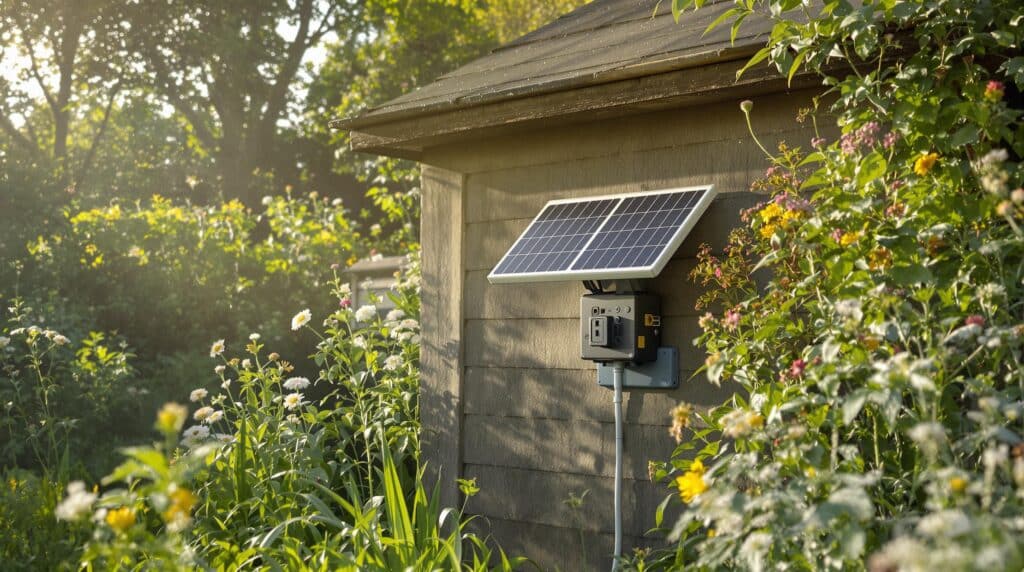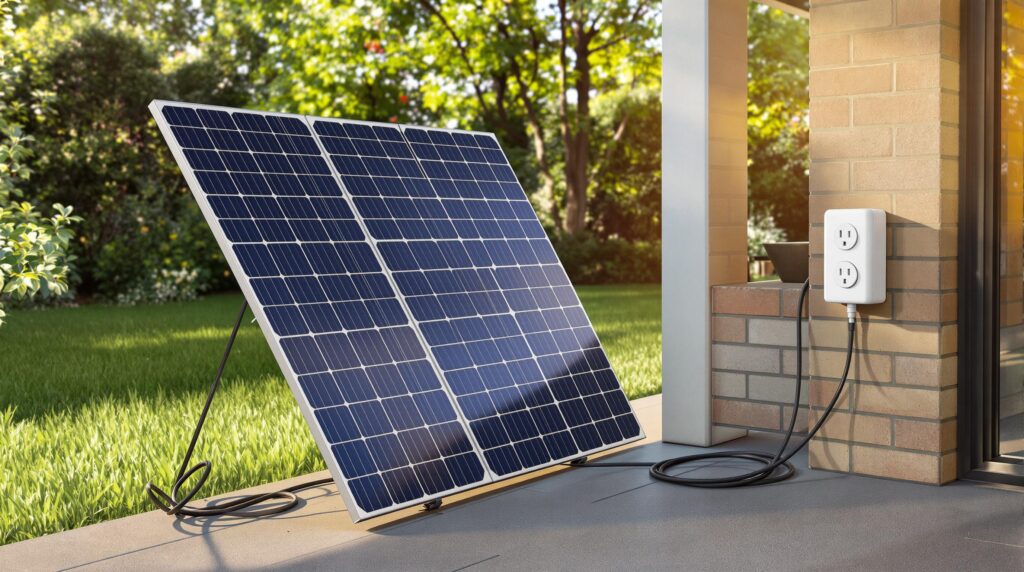The ideal solution for saving money
Do you dream of producing your own solar energy at home without any hassle? The plug-and-play solar kit is the easiest self-consumption solution to install , ideal for those who want to reduce their electricity bill with a self-consumption solar panel.
Discover how this easy solar installation, plugged directly into a socket, allows you to make concrete savings on solar energy , without any work or cumbersome administrative procedures.
Understanding Plug and Play Solar Kits
What is a plug and play solar kit?
A plug and play solar kit is a turnkey photovoltaic system that plugs directly into an electrical outlet. It converts solar energy into usable electricity to reduce your energy bill . Unlike conventional installations, it requires no work or professionals , and can be installed in just a few minutes!
Technical composition of a plug and play solar kit and explanation of the energy conversion process
A plug-and-play solar kit includes a solar panel, an integrated microinverter, and a connection cable. The light captured by the photovoltaic cells generates direct current, which the microinverter converts into alternating current. The electricity produced powers your household appliances via a standard outlet, simplifying self-consumption .
Why choose a plug and play solar kit?
Choose a plug-and-play solar kit for its ease of installation and rapid profitability . This accessible, no-construction solution is suitable for all households looking to reduce their electricity bills. A moderate investment that allows you to optimize your self-consumption by producing clean, renewable energy from your home.
- Simplified installation without the need for a professional
- Immediate savings on your electricity bill
- Fast profitability with a return on investment in 3 to 6 years
- Contribution to the energy transition and reduction of the carbon footprint
- Adaptability to various spaces (balcony, terrace, roof or floor)
- Effective coverage of the electricity consumption heel (40% on average)
- Long lifespan (25 to 30 years) and increased robustness
These advantages make it an ideal solution for getting started in self-consumption with a moderate investment and limited risk.
Plug and play solar kit: the affordable photovoltaic solution ☀️
Types of plug and play solar kits available
Plug and play solar kits come in different power outputs to suit your needs . Basic models offer a power output of 300Wp, ideal for reducing your energy consumption. More powerful versions reach 3000Wp, suitable for households wishing to increase their energy autonomy with bifacial solar panels.
Comparison of the main plug and play solar kits on the market
| Features | Sunology PLAY 2 | Beem On | Sunethic F500 |
| Nominal power (Wp) | 450 | 500 | 500 |
| Yield (%) | 22.52 | – | 22.85 |
| Price (€) | 599 | 459 | 690 |
| €/Wc | 1.33 | 0.86 | 1.38 |
| Depreciation | <3.8 years | <5 years | <6 years old |
| Annual production (kWh) | 360-630 | 400-700 | 400-700 |
| Annual savings (€) | 160 minimum | 270 maximum | 140-190 |
| Modularity (max Wc) | 1 800 | 920 | 2,000 |
| Hardware warranty | 25 years old | – | 25 years old |
| Microinverter Warranty | 25 years old | – | 20 years old |
Focus on plug and play solar kits with integrated battery
Plug and play solar kits with batteries offer a complete solution for self-consumption. The battery stores excess energy during the day for use at night or in the event of a power outage. This system maximizes your energy independence , although the additional cost of the battery must be weighed against your actual needs and the price of electricity.
Choose the plug and play solar kit that suits your needs
Important criteria to consider when choosing your plug and play solar kit
- Purchase price and financial aid available in France
- Power adapted to your annual kWh consumption
- Type of panels (monocrystalline, bifacial or photovoltaic)
- Duration and conditions of the warranty (panels, micro-inverter)
- APS microinverter performance or equivalent
- Easy to fix on roof, balcony or mobile support
To choose the right plug and play solar kit , start by evaluating your annual electricity consumption in kWh .
Choose a power source that meets your needs and check the quality of the components, such as monocrystalline or bifacial panels.
The warranty (up to 25 years), the performance of the microinverter, and the ease of installation on a balcony, roof, or ground are determining criteria .
Compare the price and financial aid available in France.
Personalized recommendations based on housing type, exposure and electricity consumption habits
Tailor your choice of plug-and-play solar kit to your home.
For an apartment with a south-, east-, or west-facing balcony, the Sunology CITY (405 Wp) is ideal, generating up to 567 kWh/year and reducing your bill by up to 12%.
In a single-family home , a power of 3 kWp (8 panels of 400 Wp) is suitable for a surface area of 100 m². In sunny regions, choose bifacial panels to maximize production.

Installation and optimal use of your plug and play solar kit 🔨
Simplified installation steps
Installing a plug and play solar kit can be done in just a few minutes!
Choose a sunny location with a stable surface, then plug the cable into a standard outlet. No tools or technical skills are required, as most systems come pre-assembled.
Position the panels facing the sun, check the electrical connection, and immediately benefit from clean and economical energy production .
Safety precautions to take
When installing, prioritize your safety : wear insulated gloves and non-slip shoes to avoid electrical or mechanical risks.
Only connect to a 230V AC 16A 2P+E socket, never to a power strip, and check that the circuit is protected by a circuit breaker.
To extend the life of the kit, clean the panels 1 to 2 times a year with water. Dirty panels can lose up to 10% of their efficiency.
Optimal placement to maximize production
The efficiency of your solar kit depends on its location. Choose a south-facing orientation with a 30 to 35° inclination for maximum production .
Avoid shaded or dusty areas, which reduce performance.
If installing on the ground or on a balcony, ensure optimal stability to withstand inclement weather and changes in climate.
Monitoring and optimizing your solar production 📱
Apps like TUYA Smart, SMA Sunny Portal, and Enphase Enlighten allow you to track your solar kit’s production in real time. They display generated power, self-consumption, and alerts in case of performance declines. These tools make it easy to adjust energy habits, maximizing the savings and profitability of your plug-and-play solar installation.
Tips for optimizing the use of energy produced
To get the most out of your solar kit, synchronize the use of energy-intensive appliances with peak production times, generally between 12 p.m. and 4 p.m. Schedule the washing machine, dishwasher, or water heater to run during these times. Home automation tools, such as a solar router, automate these uses and increase self-consumption rates up to 90% , reducing your dependence on the electricity grid and your energy costs in the long term.
Regulatory aspects and developments of plug and play solar kits
Legal framework and safety standards
In France, plug and play solar kits do not require prior authorization from the town hall if their height remains less than 1.80 m.
Plug and play solar kits must comply with specific electrical standards.
The microinverter must comply with DIN VDE 0126-1-1, the solar panel with EN 61140 (class II). Although not subject to the NF C 15-100 standard (September 2025) because they are considered mobile, they must be protected by a 30mA residual current device (RCD) to ensure a reliable and secure installation.
A 6A AC circuit breaker is recommended for kits up to 1380W. Connection is made to a 16A socket with a 30mA differential. The new NF C15-100 regulation may prohibit conventional sockets, but mobile kits are still theoretically permitted. If you have any doubts about compliance or safety, do not hesitate to consult a professional for optimal and legitimate installation.
The plug and play solar kit is a turnkey solution for simplified self-consumption ✅
Easy to install in minutes, it combines practicality and cost-effectiveness to reduce your electricity bill . Customize your choice to suit your space and habits, and enjoy solar energy accessible to all.
Ready to reduce your energy costs? The eco-responsible future starts here, with ease.
FAQ – Solar kit plug and play
What are the drawbacks of plug and play solar kits?
Although practical, plug and play solar kits have some limitations. Their production capacity is often limited, designed mainly to supplement consumption and reduce the base load, not to cover all household needs, especially energy-intensive appliances. In addition, their efficiency can be variable and unpredictable, as it depends heavily on orientation, sunlight, and shading, making performance difficult to guarantee. Another major drawback is the inability to make use of surplus production: unused electricity is injected into the grid free of charge, without financial compensation or access to subsidies. Finally, despite their ease of installation, there is a potential electrical risk if the home installation is not checked, making caution and prior verification essential for your safety.
What is the best plug and play solar kit?
The « best » plug and play solar kit is not universal; it mainly depends on your specific needs, your budget, and your home installation conditions. To make an informed choice, it is essential to consider your base load consumption, the available installation surface, and the possible orientation of your panels. Among the top models, the Sunology PLAY 2 is recognized for its performance and extended warranties, the Beem On for its accessibility and integrated monitoring, while the Sunethic F500 stands out for its power and component quality. The Ekwateur 500 Wc offers an excellent balance with fast profitability and high recyclability. Each kit has its strengths, allowing you to find the solution best suited to your self-consumption project.
What is the lifespan of the Sunology PLAY Max battery?
The battery of the Sunology PLAY Max kit, using Lithium-Ion technology, is designed for long life. It is estimated at around 2,500 charge and discharge cycles, which represents approximately 7 years of use under normal conditions. Sunology guarantees this battery for 10 years or 2,500 cycles, thus ensuring durable and reliable performance for your self-consumption.
